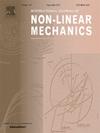Energy-constrained Lagrangian neural networks for data-driven modeling of robotic systems: Method and prosthetic applications
IF 3.2
3区 工程技术
Q2 MECHANICS
International Journal of Non-Linear Mechanics
Pub Date : 2025-10-10
DOI:10.1016/j.ijnonlinmec.2025.105283
引用次数: 0
Abstract
Dynamic models are crucial for model-based control of multi-degree-of-freedom systems, particularly in robotic applications. While traditional methodologies, including Newtonian and Lagrangian mechanics, have been widely employed, they exhibit limitations in accurately capturing unstructured factors such as joint friction and transmission flexibility. Inspired by the physical interpretability inherent in Lagrangian mechanics and the universal approximation capabilities of neural networks, this paper introduces a novel Energy-constrained Lagrangian Neural Network (EnLNN) modeling framework. The proposed EnLNN decomposes the acceleration field into conservative and nonconservative components, with the former represented by a Lagrangian Neural Network (LNN) and the latter by a feedforward neural network (FNN). A distinctive feature of the EnLNN is its incorporation of energy constraints, which allows the conservative component to preserve energy to the greatest extent, thereby mitigating the misallocation of force fields between conservative and nonconservative components. This approach yields a more precise Lagrangian representation than conventional LNNs. The efficacy of the EnLNN modeling approach was evaluated through numerical simulation of a double pendulum system and experimental validation on a lower limb prosthesis. The results substantiate that the EnLNN framework effectively distinguishes conservative and nonconservative components from empirical data while maintaining high modeling accuracy and demonstrating robust extrapolation capabilities.
数据驱动机器人系统建模的能量约束拉格朗日神经网络:方法和假肢应用
动态模型对于多自由度系统的基于模型的控制至关重要,特别是在机器人应用中。虽然包括牛顿力学和拉格朗日力学在内的传统方法已被广泛采用,但它们在准确捕捉关节摩擦和传动灵活性等非结构化因素方面存在局限性。受拉格朗日力学固有的物理可解释性和神经网络的通用逼近能力的启发,提出了一种新的能量约束拉格朗日神经网络(EnLNN)建模框架。提出的EnLNN将加速度场分解为保守和非保守分量,其中保守分量由拉格朗日神经网络(LNN)表示,非保守分量由前馈神经网络(FNN)表示。EnLNN的一个显著特点是它结合了能量约束,这使得保守分量能够最大程度地保留能量,从而减轻了保守和非保守分量之间力场的错配。这种方法产生了比传统LNNs更精确的拉格朗日表示。通过双摆系统的数值模拟和下肢假肢的实验验证,对EnLNN建模方法的有效性进行了评估。结果表明,EnLNN框架有效地从经验数据中区分了保守和非保守成分,同时保持了较高的建模精度,并展示了强大的外推能力。
本文章由计算机程序翻译,如有差异,请以英文原文为准。
求助全文
约1分钟内获得全文
求助全文
来源期刊
CiteScore
5.50
自引率
9.40%
发文量
192
审稿时长
67 days
期刊介绍:
The International Journal of Non-Linear Mechanics provides a specific medium for dissemination of high-quality research results in the various areas of theoretical, applied, and experimental mechanics of solids, fluids, structures, and systems where the phenomena are inherently non-linear.
The journal brings together original results in non-linear problems in elasticity, plasticity, dynamics, vibrations, wave-propagation, rheology, fluid-structure interaction systems, stability, biomechanics, micro- and nano-structures, materials, metamaterials, and in other diverse areas.
Papers may be analytical, computational or experimental in nature. Treatments of non-linear differential equations wherein solutions and properties of solutions are emphasized but physical aspects are not adequately relevant, will not be considered for possible publication. Both deterministic and stochastic approaches are fostered. Contributions pertaining to both established and emerging fields are encouraged.

 求助内容:
求助内容: 应助结果提醒方式:
应助结果提醒方式:


